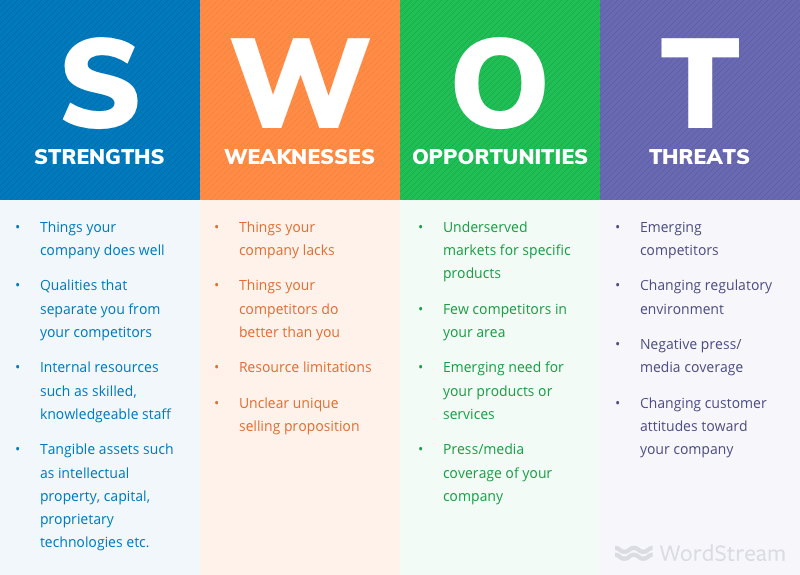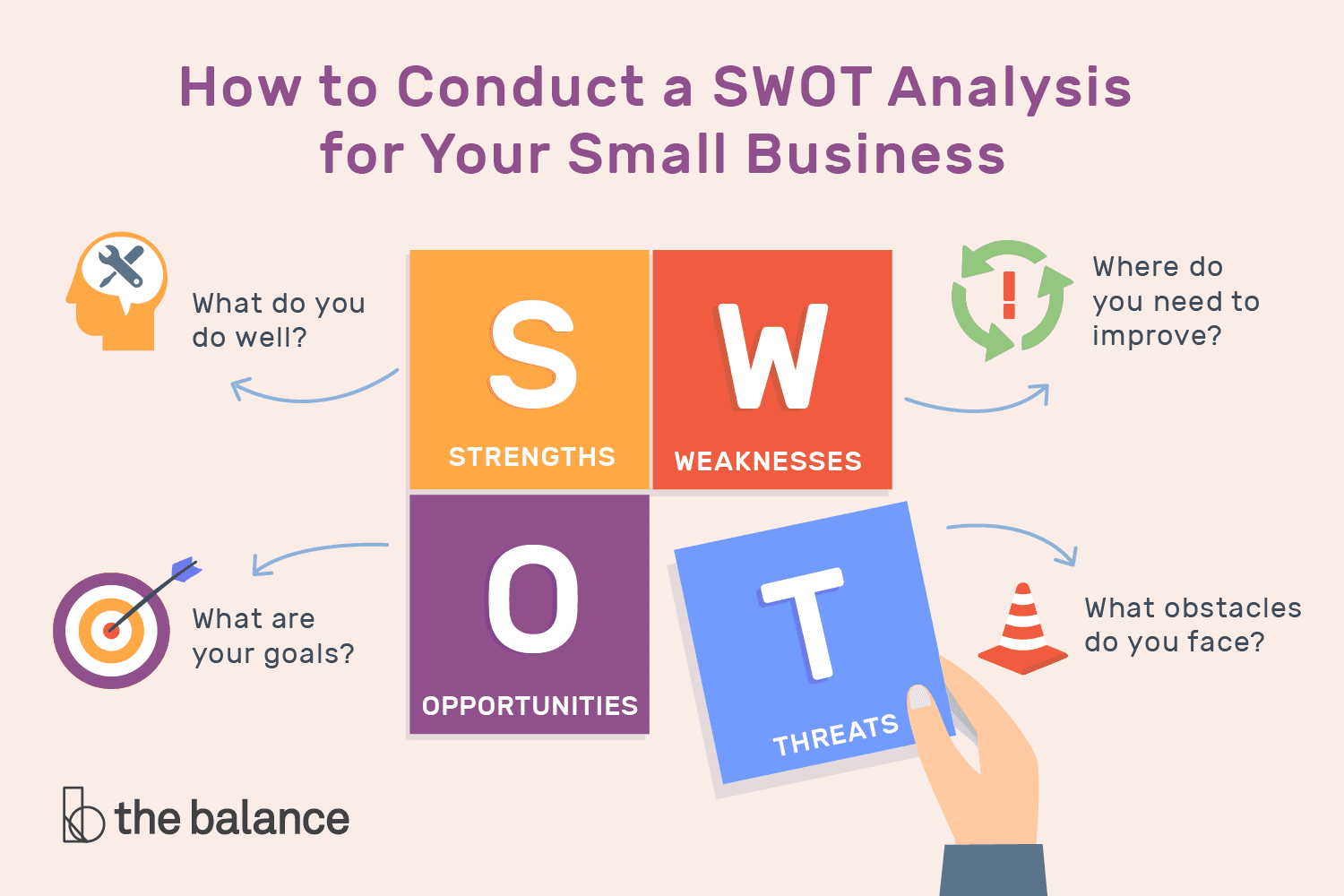To conduct a SWOT analysis, identify your business’s strengths, weaknesses, opportunities, and threats. Use this information to make informed strategic decisions.
A SWOT analysis is a vital tool for evaluating your business’s internal and external factors. By identifying strengths, weaknesses, opportunities, and threats, you gain a comprehensive understanding of your market position. This analysis aids in strategic planning and decision-making, helping you capitalize on strengths and opportunities while addressing weaknesses and threats.
It’s essential for staying competitive and resilient. Regularly updating your SWOT analysis ensures you remain proactive in an ever-changing business environment. Effective SWOT analysis ultimately drives business growth and success by aligning your strategies with your core capabilities and market conditions.
Introduction To Swot Analysis
SWOT Analysis is a tool for understanding your business. It helps you identify strengths, weaknesses, opportunities, and threats. This analysis provides a clear picture of your situation. It is a strategic planning tool used by businesses worldwide.
Purpose And Benefits
The purpose of a SWOT Analysis is to support strategic planning. It helps you see internal and external factors. Understanding these factors can guide your decisions.
Some benefits include:
- Identifying strengths to build on
- Spotting weaknesses to address
- Finding opportunities for growth
- Recognizing threats to mitigate
A SWOT Analysis can also foster teamwork and communication. It encourages open discussion about the business.
When To Use Swot Analysis
Use SWOT Analysis in various situations. Below are some key times:
- Launching a new project or product
- Entering a new market
- Planning a new business strategy
- Assessing current strategies
- During regular business reviews
Regular SWOT analyses keep your business on track. They help you adapt to changes and stay competitive.
Preparing For The Swot Analysis
Conducting a SWOT analysis can help your business identify strengths, weaknesses, opportunities, and threats. Proper preparation is key to success. This section will guide you through the essential steps to prepare effectively.
Gathering Relevant Data
Start by collecting data that represents your business environment. This data can come from various sources such as:
- Internal reports
- Customer feedback
- Market research
- Competitor analysis
Make sure you gather both qualitative and quantitative data. Qualitative data includes customer reviews, while quantitative data involves sales figures. This balance helps create a complete picture.
Use a table to organize the collected data:
| Data Source | Type of Data | Relevance |
|---|---|---|
| Internal Reports | Quantitative | High |
| Customer Feedback | Qualitative | Medium |
| Market Research | Both | High |
| Competitor Analysis | Both | High |
Identifying Key Participants
Choose the right team for the SWOT analysis. This team should include:
- Senior managers
- Department heads
- Customer service reps
- Sales staff
These participants bring diverse perspectives to the table. Their insights can help identify all relevant factors. Each team member should understand the business well.
Here’s a checklist to ensure you have the right participants:
- Invite diverse team members.
- Ensure they understand the business.
- Provide them with collected data.
Gathering the right team ensures a thorough SWOT analysis. It also facilitates better decision-making.
Analyzing Strengths
Conducting a SWOT analysis for your business involves identifying strengths, weaknesses, opportunities, and threats. This helps in understanding internal and external factors. Analyzing strengths is a crucial part of this process. It reveals what your business does well and what sets it apart from competitors.
Internal Capabilities
Your business’s internal capabilities are the core strengths that drive success. These include unique skills, resources, and processes. Here are some examples:
- Skilled workforce: Having a team with specialized skills.
- Advanced technology: Using state-of-the-art equipment and software.
- Strong brand reputation: Being recognized and trusted by customers.
- Efficient operations: Streamlined processes that save time and money.
Identify and list these capabilities. They highlight where your business excels.
Competitive Advantages
Your business’s competitive advantages differentiate it from rivals. These advantages can include:
| Competitive Advantage | Description |
|---|---|
| Unique Products | Offering products that others don’t have. |
| Customer Loyalty | Having a loyal customer base that keeps returning. |
| Cost Leadership | Providing products or services at a lower cost. |
| Innovation | Introducing new and creative solutions. |
These advantages should be clearly identified. They help your business stand out in the market.

Credit: www.wordstream.com
Evaluating Weaknesses
Evaluating weaknesses is a critical step in a SWOT analysis for your business. Identifying and understanding your business’s weaknesses can help you develop strategies to improve and grow. This section will guide you through evaluating internal challenges and areas for improvement.
Internal Challenges
Internal challenges are the obstacles within your business that hinder progress. These can include insufficient resources, lack of expertise, or outdated technology. Addressing these issues helps your business run smoothly.
- Insufficient Resources: Limited budget or manpower can restrict growth.
- Lack of Expertise: Missing skills can impact productivity and quality.
- Outdated Technology: Old systems can slow down operations and reduce efficiency.
Addressing internal challenges involves recognizing and tackling them head-on. This may mean hiring skilled staff, upgrading technology, or reallocating resources.
Areas For Improvement
Identifying areas for improvement helps you pinpoint specific weaknesses. These are the aspects of your business that need enhancement.
| Weakness | Improvement Strategy |
|---|---|
| Poor Customer Service | Train staff, implement feedback systems |
| Low Employee Morale | Introduce incentive programs, improve work environment |
| Ineffective Marketing | Revamp marketing strategy, leverage social media |
Focusing on these areas will help your business become more competitive. Improved customer service, employee morale, and marketing can significantly boost your overall performance.
Identifying Opportunities
Identifying opportunities in a SWOT analysis is crucial for business growth. Opportunities are external factors that your business can leverage. These can drive your business forward. Let’s dive into how to spot these opportunities.
Market Trends
Understanding market trends helps you stay ahead of competitors. Analyze what products or services are gaining popularity. Look at customer preferences and buying habits. Use data from industry reports and surveys. This information can reveal untapped areas.
- What new technologies are emerging?
- Are there shifts in consumer behavior?
- What are your competitors doing differently?
Answering these questions can help you identify potential opportunities. Focus on trends that align with your business goals.
Growth Prospects
Identifying growth prospects involves looking at potential areas for expansion. Are there new markets you can enter? Can you diversify your product line?
| Growth Area | Action |
|---|---|
| New Markets | Research and analyze potential customer base. |
| Product Diversification | Develop new products that meet market demand. |
Explore partnership opportunities and joint ventures. Collaborations can open new doors. They provide access to resources and expertise.
Use these insights to create a strategic plan. Focus on areas that offer the most promise. This way, you can drive sustainable growth.
Recognizing Threats
Recognizing threats is a crucial part of a SWOT analysis for your business. Identifying threats helps you prepare and safeguard your business. This section will cover external risks and competitive pressures that may impact your business.
External Risks
External risks are potential dangers from outside your business. These can affect your operations and growth. Understanding these risks helps you create effective strategies.
- Economic Changes: Recession or inflation can impact your sales.
- Regulatory Changes: New laws can affect how you do business.
- Technological Advancements: New tech can make your products outdated.
- Natural Disasters: Events like floods or earthquakes can disrupt business.
Stay updated with news and trends. This helps you spot external risks early.
Competitive Pressures
Competitive pressures come from other businesses in your industry. They can affect your market share and profitability. Recognizing these pressures helps you stay ahead.
- New Entrants: New competitors can reduce your market share.
- Price Wars: Competitors may lower prices, affecting your profits.
- Product Innovations: Competitors with better products can attract your customers.
- Marketing Strategies: Strong marketing from competitors can overshadow your efforts.
Analyze your competitors regularly. This helps you understand their strategies and plan accordingly.
Compiling The Swot Matrix
Compiling the SWOT Matrix is a critical step for your business. This matrix helps you see your strengths, weaknesses, opportunities, and threats in one place. A well-organized matrix can guide your strategic decisions effectively.
Organizing Findings
Start by gathering all your data from the SWOT analysis. This data will be divided into four categories:
- Strengths: Internal factors that give your business an advantage.
- Weaknesses: Internal factors that put your business at a disadvantage.
- Opportunities: External factors that your business can exploit.
- Threats: External factors that could cause trouble for your business.
Use a table to organize these findings:
| Strengths | Weaknesses |
|---|---|
| High customer loyalty | Poor online presence |
| Strong brand reputation | Limited budget |
| Opportunities | Threats |
| Emerging markets | New competitors |
| Technology advancements | Economic downturn |
Visual Representation
A visual representation can make your SWOT matrix easier to understand. Create a simple grid with four quadrants:
- Top-left: Strengths
- Top-right: Weaknesses
- Bottom-left: Opportunities
- Bottom-right: Threats
Here’s a sample layout:
Use colors to differentiate each category. This visual aid helps in quick reference and decision-making.
:max_bytes(150000):strip_icc()/SWOTAnalysis_final-d57d99fb6e1a45bf81e84763736d87f0.png)
Credit: www.investopedia.com
Developing Strategies
Once you have identified your strengths, weaknesses, opportunities, and threats, it’s time to develop strategies. These strategies will help your business grow and succeed. You can use your SWOT analysis to create actionable plans. These plans will guide your business towards its goals.
Leveraging Strengths
Use your strengths to gain a competitive edge. Focus on what your business does best. Here are some steps:
- Highlight your unique selling points (USPs).
- Enhance customer satisfaction using your strengths.
- Invest in areas where you excel.
Mitigating Weaknesses
Addressing weaknesses is crucial for growth. Identify areas needing improvement. Here are some ways to mitigate weaknesses:
- Provide training to improve skills.
- Outsource tasks you struggle with.
- Invest in new technology.
Capitalizing On Opportunities
Opportunities can drive your business forward. Actively seek and utilize them. Here are some tips:
- Stay updated with market trends.
- Expand your product or service line.
- Partner with other businesses.
Defending Against Threats
Threats can harm your business if not addressed. Protect your business by:
- Monitoring competitors closely.
- Having a risk management plan.
- Adapting quickly to market changes.
Below is a table summarizing these strategies:
| Aspect | Strategy |
|---|---|
| Strengths | Highlight USPs, enhance customer satisfaction, invest in strengths. |
| Weaknesses | Provide training, outsource tasks, invest in technology. |
| Opportunities | Stay updated, expand offerings, partner with others. |
| Threats | Monitor competitors, risk management, adapt to changes. |
Implementing The Action Plan
Once you have completed your SWOT analysis, the next step is implementing the action plan. This phase is crucial to turn insights into tangible results. Below are the key steps to take.
Setting Priorities
To start, list your strengths, weaknesses, opportunities, and threats. Rank them based on their impact on your business. Focus on the most critical factors first. Use a table to organize and visualize your priorities.
| Priority | Element | Action |
|---|---|---|
| 1 | Strength | Enhance social media presence |
| 2 | Weakness | Improve customer service |
| 3 | Opportunity | Expand to new markets |
| 4 | Threat | Monitor competitor activities |
Assigning Responsibilities
Next, assign responsibilities to your team members. Ensure everyone knows their role. Clear assignments help in executing the plan efficiently. List the tasks and the responsible person.
- Enhance social media presence – Assigned to Marketing Team
- Improve customer service – Assigned to Customer Support Team
- Expand to new markets – Assigned to Sales Team
- Monitor competitor activities – Assigned to Research Team
Monitoring Progress
Finally, monitor the progress of your action plan. Regularly check if tasks are on track. Use metrics and KPIs to evaluate success. Create a simple table to keep track of progress.
| Task | Status | Progress |
|---|---|---|
| Enhance social media presence | In Progress | 50% |
| Improve customer service | Completed | 100% |
| Expand to new markets | Not Started | 0% |
| Monitor competitor activities | In Progress | 30% |

Credit: www.liveplan.com
Review And Update
Conducting a SWOT analysis is crucial for any business. Regularly reviewing and updating your SWOT analysis ensures its relevance. This practice helps in navigating market changes effectively.
Regular Assessments
It’s important to conduct regular assessments of your SWOT analysis. This helps in identifying new strengths, weaknesses, opportunities, and threats. Schedule assessments quarterly or bi-annually.
Use the following table to organize your review schedule:
| Frequency | Action |
|---|---|
| Quarterly | Review internal factors |
| Bi-Annually | Evaluate external factors |
Adjusting Strategies
Based on the assessments, adjust your strategies. Identify what needs improvement or change. This helps in staying competitive and relevant.
- Update marketing strategies
- Refine product offerings
- Enhance customer service
Ensure that all team members understand the new strategies. This promotes alignment and effective implementation.
Regular reviews and updates are essential for business growth. Stay proactive and adaptive to ensure success.
Frequently Asked Questions
How Do I Create A Swot Analysis For My Business?
To create a SWOT analysis, identify your business’s strengths, weaknesses, opportunities, and threats. Use bullet points for clarity. Assess internal factors (strengths, weaknesses) and external factors (opportunities, threats). Gather input from team members. Regularly update the analysis to reflect changes in the market or business.
How To Conduct The Swot Analysis?
To conduct a SWOT analysis, identify strengths, weaknesses, opportunities, and threats. Analyze each category thoroughly. Use insights to develop strategies.
What Are The 5 Points Of Swot Analysis?
SWOT analysis includes five key points: Strengths, Weaknesses, Opportunities, Threats, and Trends. These elements help evaluate a business’s strategic position.
What Is A Swot Analysis In Business Example?
A SWOT analysis evaluates a business’s Strengths, Weaknesses, Opportunities, and Threats. For example, a coffee shop’s strengths might include high-quality products, weaknesses could be limited seating, opportunities might involve expanding to new locations, and threats could be increased competition.
Conclusion
Mastering a SWOT analysis can transform your business strategy. It helps identify strengths, weaknesses, opportunities, and threats. Utilize this tool to make informed decisions and drive growth. Regularly revisiting your SWOT analysis ensures you stay ahead in a competitive market.
Start your SWOT analysis journey today for a successful business future.

Elaine C. Durham is a distinguished figure in the domain of new business investments, recognized for her expertise and strategic acumen in navigating the dynamic landscape of emerging ventures. With a robust educational background and a wealth of experience, Elaine has become a trusted authority in the field, contributing valuable insights to the realm of investment strategies for nascent businesses. Her professional journey is marked by a keen ability to identify promising opportunities, coupled with a shrewd understanding of market dynamics and risk management. Known for her innovative approach and successful endeavors, Elaine C. Durham stands as a beacon for entrepreneurs and investors alike, offering a wealth of knowledge on fostering growth and sustainability in the ever-evolving world of new business investments.


